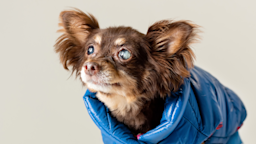Key takeaways:
On average, dog cataract surgery ranges from $2,800 to $4,900. But the price varies significantly depending on the health of your pet and the type of surgery needed.
Diagnostic testing and preliminary examinations can increase the total price you pay for your pet’s cataract surgery. So it’s important to discuss what is involved in your dog’s treatment in advance.
Pet insurance, financial assistance, and credit lines may help you cover dog’s cataract surgery costs.
As your dog ages, you may notice their eyes becoming foggy or hazy. Cloudy eyes can be a natural part of a senior dog’s life. But it can also indicate a medical issue, such as cataracts.
If your veterinarian confirms your dog has cataracts, the next step may be surgery. Whether the operation is on one or both eyes, you can expect the cost of dog cataract surgery to be in the thousands.
But there are ways you can save money on your dog’s cataract surgery, including comparison shopping and veterinary school services.
Search and compare options
What are cataracts?
When a dog’s eye is healthy, the lens is clear, allowing incoming light to pass through to the retina. But with a canine cataract, the lens is clouded, preventing light from reaching the retina. Cataracts form when proteins in the eye clump together, leading to decreased vision or blindness.
Symptoms of cataracts in dogs include:
Cloudy, white eyes
Difficulty in bright light or pure darkness
Moving cautiously
Tending to stay closer than usual to their owner
How much does dog cataract surgery cost?
The average cost of dog cataract surgery could be anywhere from $2,800 to $4,900. But the initial charge may not include:
Preliminary examination
Electroretinogram (ERG)
Ocular ultrasound
Operating room use
Anesthesia
Hospitalization
Medications
What factors affect the cost of dog cataract surgery?
The total cost of dog cataract surgery depends on many factors, such as the specifics of the procedure and the veterinary ophthalmologist’s expertise. Some things to consider when you’re looking into options for your pet are:
Type of surgery: While opting for phacoemulsification means a shorter surgery and healing period for your dog, it’s more expensive than extracapsular surgery, another primary method of dog cataract removal.
Pre-surgery procedures: Veterinary ophthalmologists must use ERGs, ocular ultrasounds, and other diagnostic tests to qualify dogs for cataract surgery.
Geographic location: The city, state, or region where the operation occurs may affect dog cataract surgery costs.
Expertise: Veterinary ophthalmology is a specialty. The more expertise your dog’s veterinary ophthalmologist has, the higher the expense.
Read more like this
Explore these related articles, suggested for readers like you.
It’s important to shop around to get a better idea of how much you may have to pay for dog cataract surgery based on your pet’s health condition. On their website, Eye Specialists for Animals, a Colorado-based veterinary practice, quotes $2,800 to $3,000 for unilateral cataract removal (one eye) and $3,800 to $4,200 for bilateral cataract removal (both eyes). Postoperative reevaluations are included in that price, but the site indicates that the following costs are not included and may be necessary for treatment:
Initial exam: $208 (not including medications)
ERG: $410
Ocular ultrasound: $220
Preoperative blood work: $209
Blood pressure measurement: $36
At another Colorado clinic, Animal Eye Center, the estimate is $3,600 to $4,000 for cataract removal with one IOL and $4,100 to $4,900 for two IOLs. (An IOL, or intraocular lens, is an artificial lens that replaces the dog’s natural lens.) These charges include the initial exam and three reevaluations. But the ERG ($250 to $350), the ocular ultrasound ($400 to $800), and additional recheck exams ($75 to $105) aren’t covered in the base prices.
At the University of Missouri Veterinary Health Center, the estimated price is $3,500 to $3,800 for cataract surgery in one eye and $4,200 to $4,600 for both eyes. This cost covers the initial consultation and diagnostics tests. But reevaluations ($170 each), additional procedures after the surgery, and medication refills aren’t included.
The specifics of what is and isn’t covered in the base price is significant, since your dog will go through a series of postoperative reevaluations the first year after surgery. After that, they’ll need to have reevaluations at least once a year for the rest of their life.
Is cataract surgery for dogs worth it?
Dog cataract surgery has many benefits. The operation restores sight and has a success rate of 80% to 90%. And it can prevent secondary issues associated with cataracts, including:
Glaucoma
Lens luxation
Retinal detachment
Lens-induced uveitis
But there are also reasons that you may want to hold off on surgery. Dog cataract surgery may not be right for your pet if they have:
Unhealthy eyes
Unstable health
Poor life expectancy
Challenging temperament
What will happen if cataracts are left untreated in dogs?
If left untreated, dog cataracts can lead to blindness, inflammation, and eye removal. Dogs that aren’t cataract surgery candidates may go blind or lose their eyes. But they can still have a good quality of life by using their other senses to get around safely.
The level of visual impairment depends on how much of the lens is covered and whether the cataract progresses. When 30% of a dog’s lens is covered, their vision rarely decreases. When 60% of the lens is covered, some impairment is likely. Once 100% of the lens is covered, the dog will go blind in that eye.
Ways to save money on dog cataract surgery
Cataract surgery for dogs can be expensive depending on who you choose to perform the procedure and the complexity of your pet’s condition.
Here are some ways to reduce the cost of dog cataract surgery and your pet’s veterinary bills:
Use pet insurance. A pet insurance policy can help pay for significant expenses like cataract surgery. But many policies don’t cover preexisting conditions. So you’ll likely need to have had coverage before your dog developed cataracts.
Compare costs. Get quotes from different veterinary ophthalmologists and pay close attention to which costs are included in the base price and which aren’t.
Seek financial assistance. Organizations and programs such as the Pet Fund and Bond’s Fund may be able to offer you financial support for dog cataract surgery.
Check out veterinary schools. These institutions sometimes provide low-cost cataract surgery for dogs. Or the staff may be able to point you toward more affordable services.
Ask about payment options. Your veterinary ophthalmologist may offer a payment plan or partner with a credit line, like CareCredit.
But, remember, the cost of dog cataract surgery is not the only factor you should consider when investigating your options. You should also assess a veterinary ophthalmologist's experience, reputation, and personality before scheduling the operation.
The bottom line
Dog cataract surgery can cost thousands of dollars depending on your pet’s health and the type of procedure they need. It’s important to consult with different veterinarians to discuss your treatment options and the potential costs.
Not all dogs with cataracts are candidates for surgery or need operations. If your veterinarian believes your dog would benefit from cataract surgery, they’ll refer you to a veterinary ophthalmologist for a consultation. If you can’t afford dog cataract surgery costs upfront, you may qualify for financial assistance or be able to set up a payment plan.

Why trust our experts?



References
Animal Eye Center. (n.d.). Pricing.
CareCredit. (2021). Cat and dog cataract surgery cost and financing.
Cornell Richard P. Riney Canine Health Center. (n.d.). Canine cataracts.
Eye Specialists for Animals. (n.d.). Cost of surgery/treatment.
Frankie’s Friends. (n.d.). Bond’s Fund.
Oklahoma State University. (2020). Clearing up canine cataracts.
Ramkumar, H. L., et al. (2022). Electroretinogram. EyeWiki.
University of Missouri Veterinary Health Center. (2022). Cataracts: What to expect.
Weir, M., et al. (n.d.). Cataracts in dogs. VCA Animal Hospitals.
















